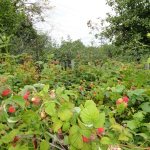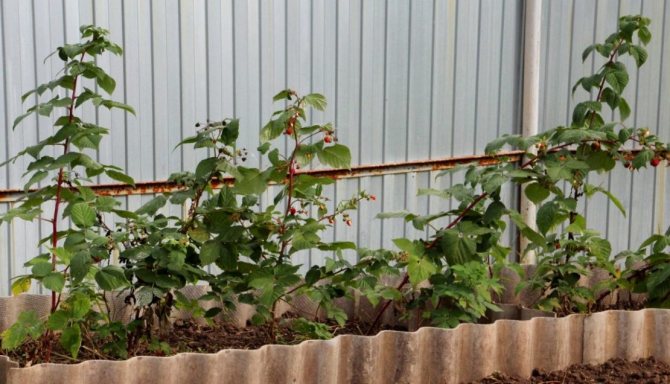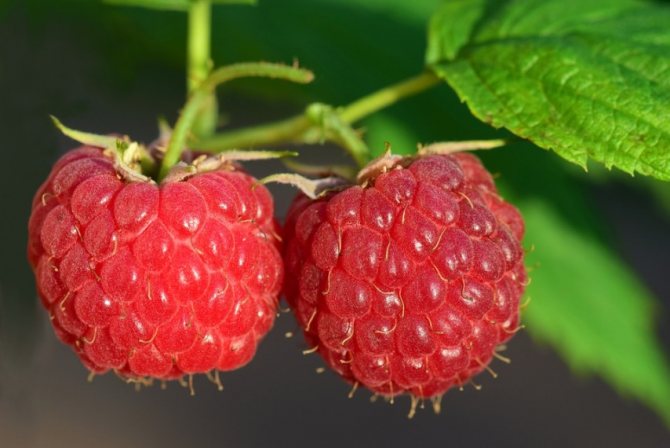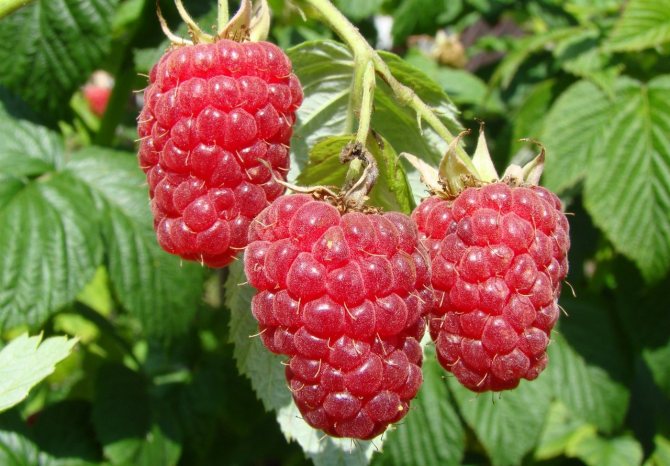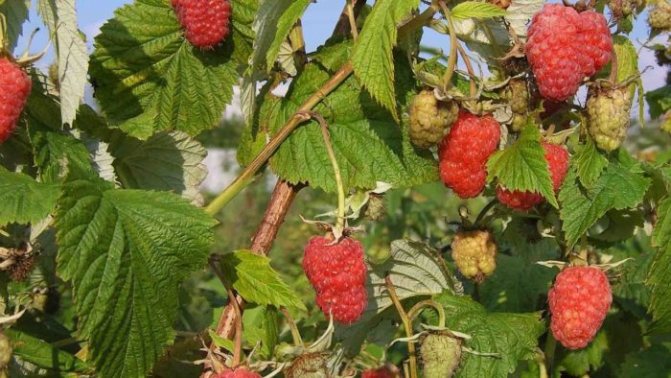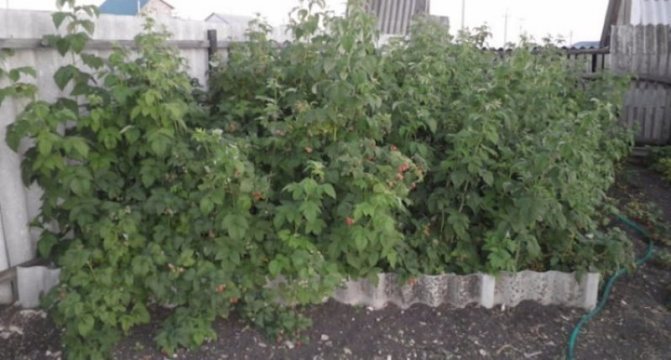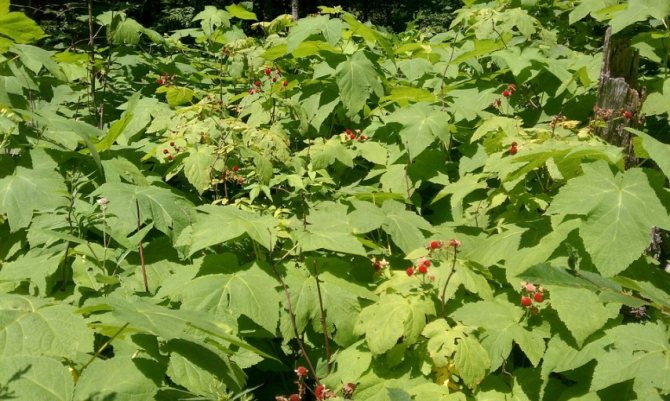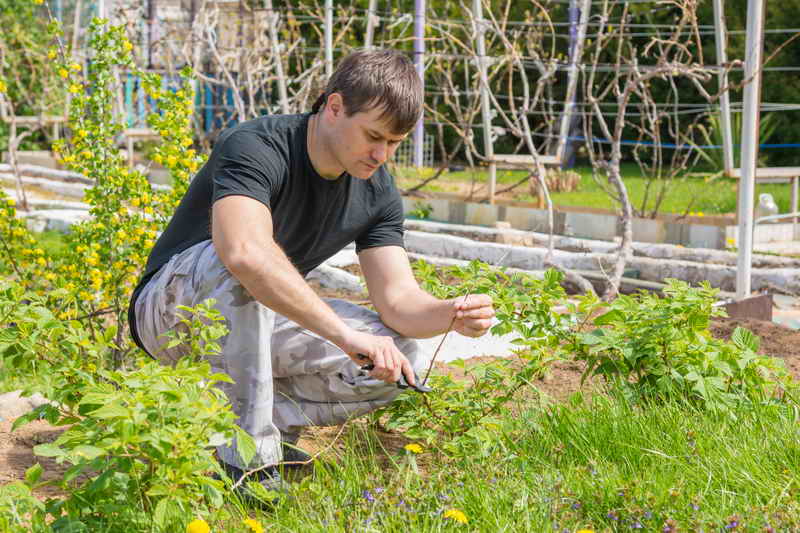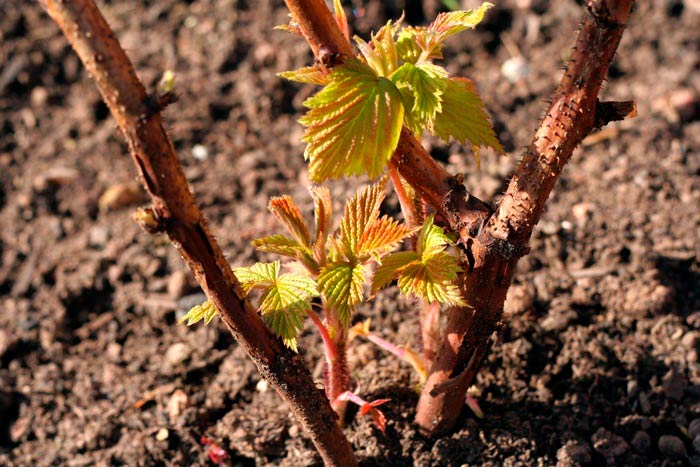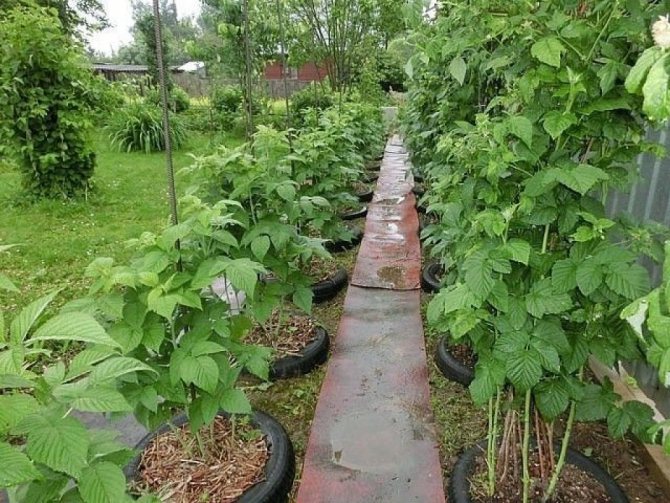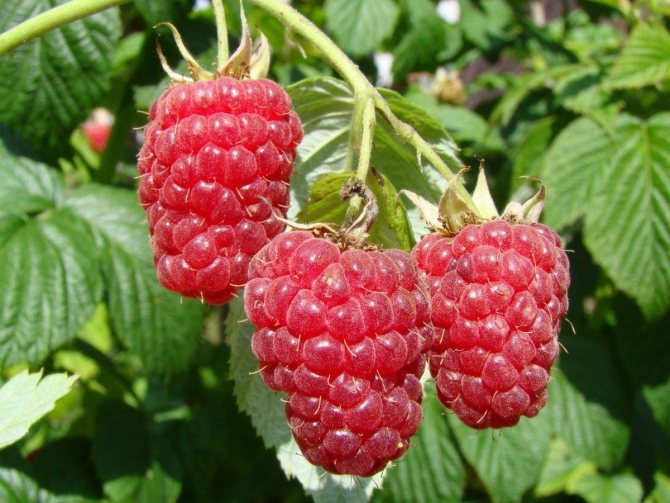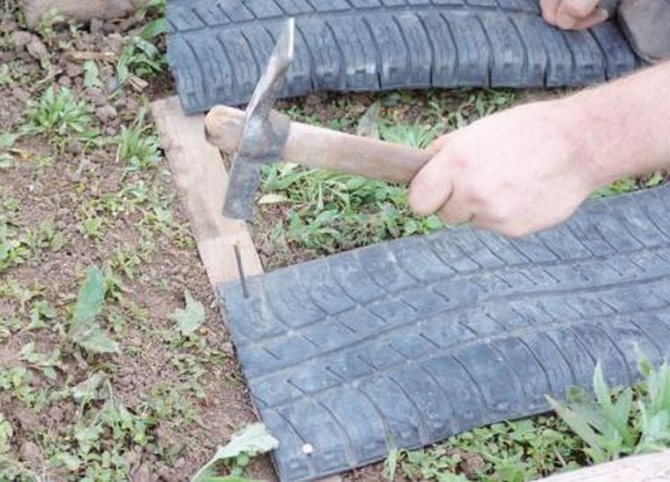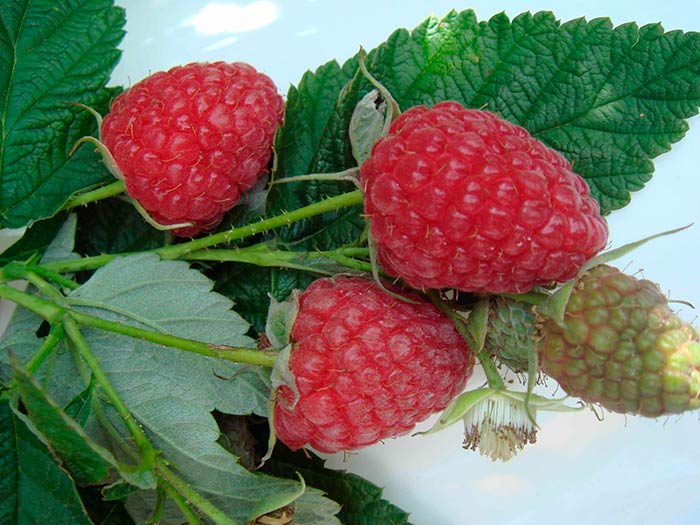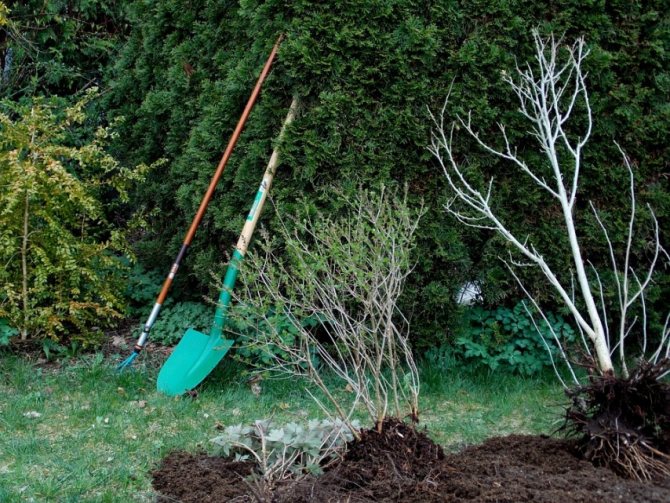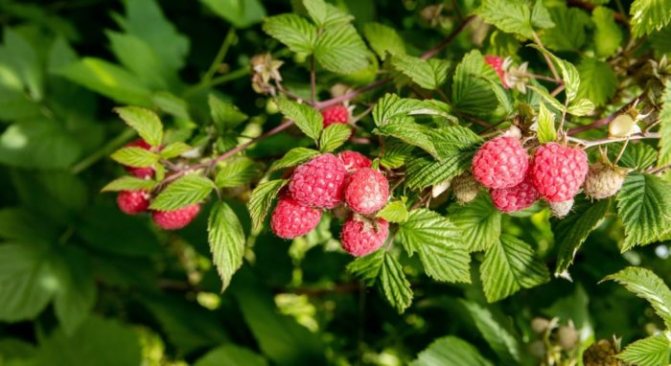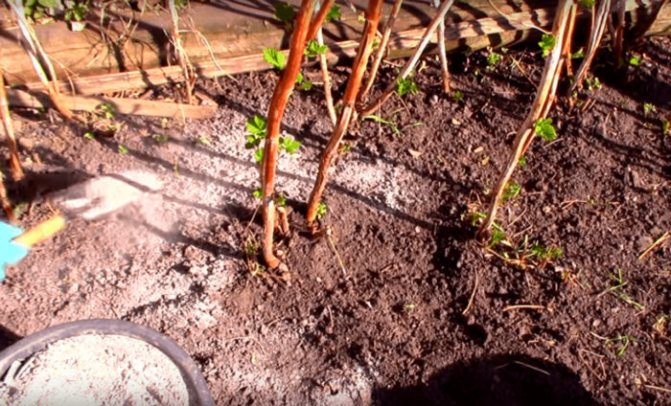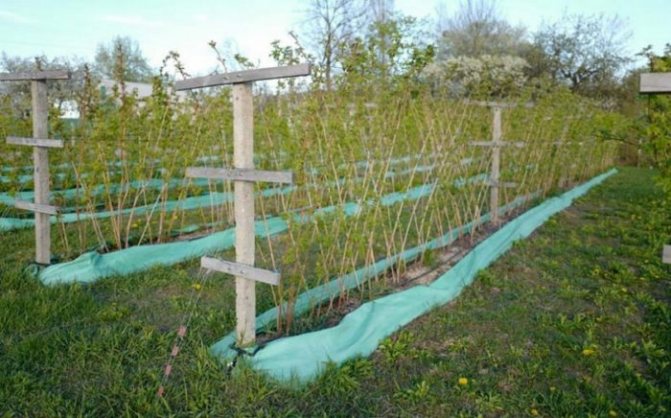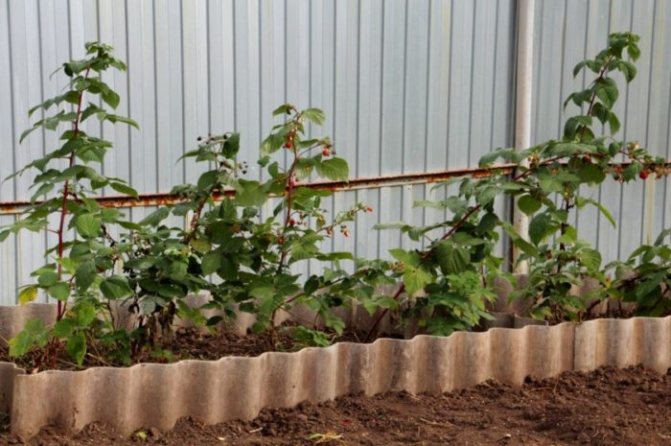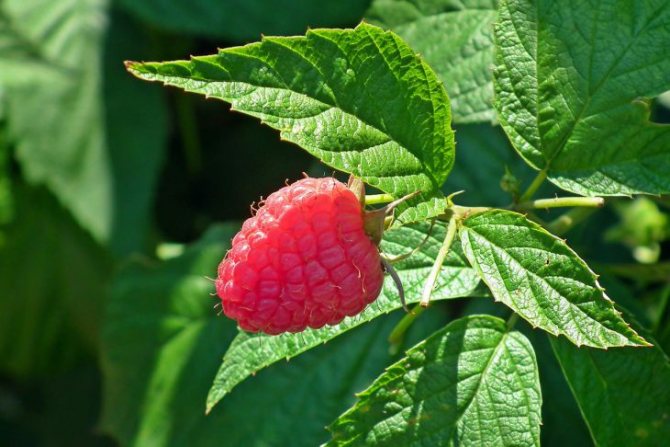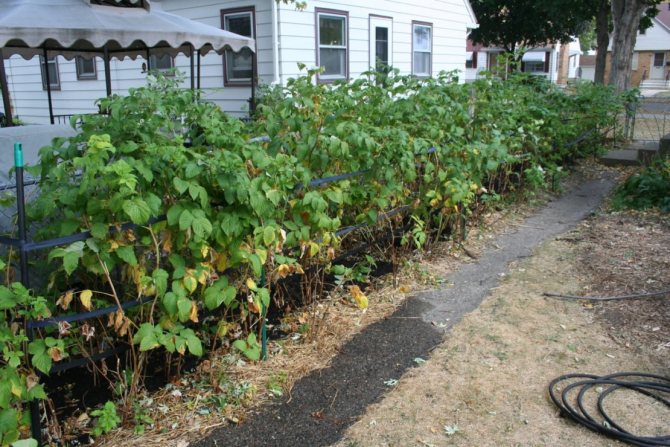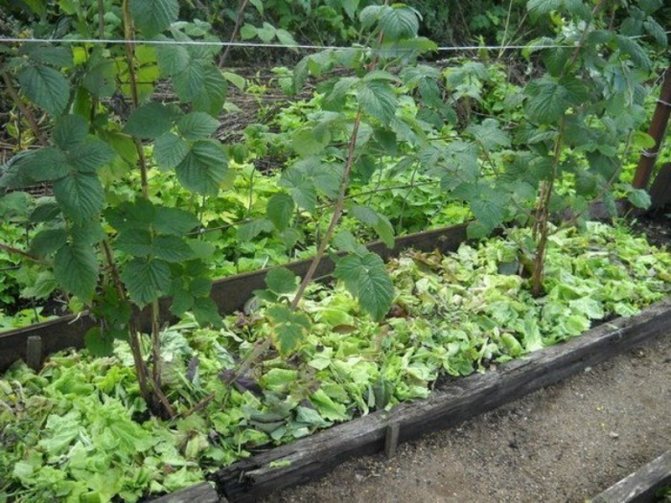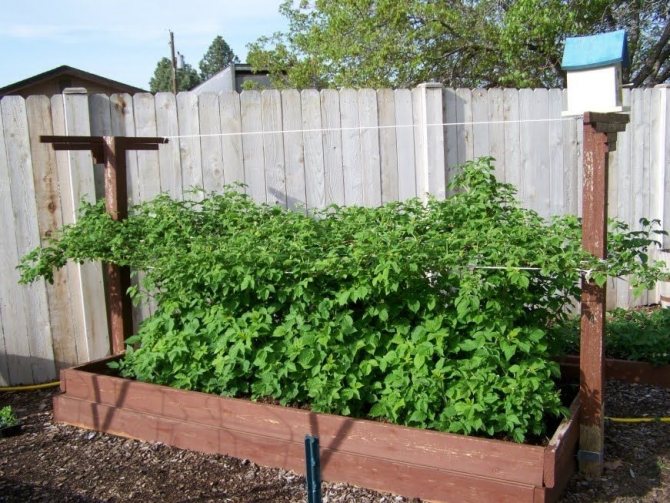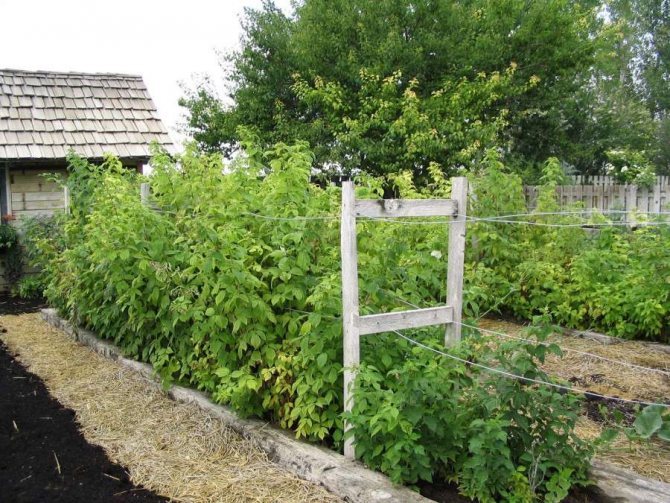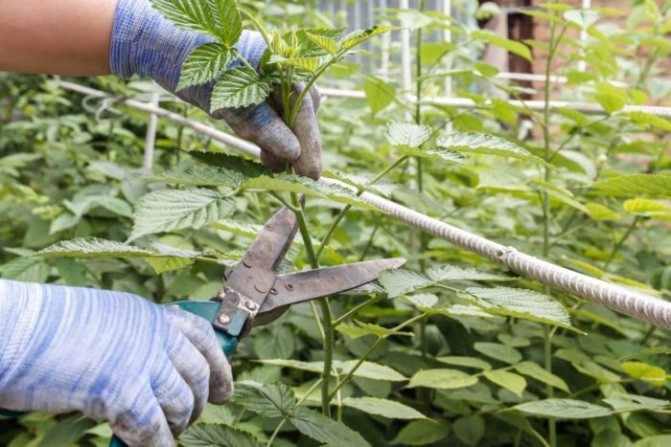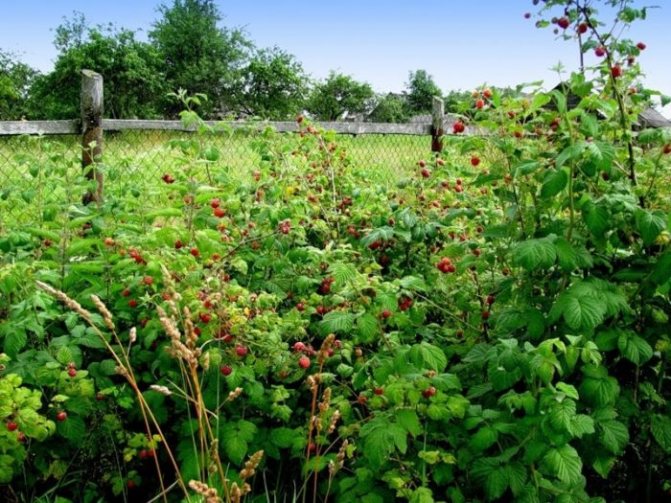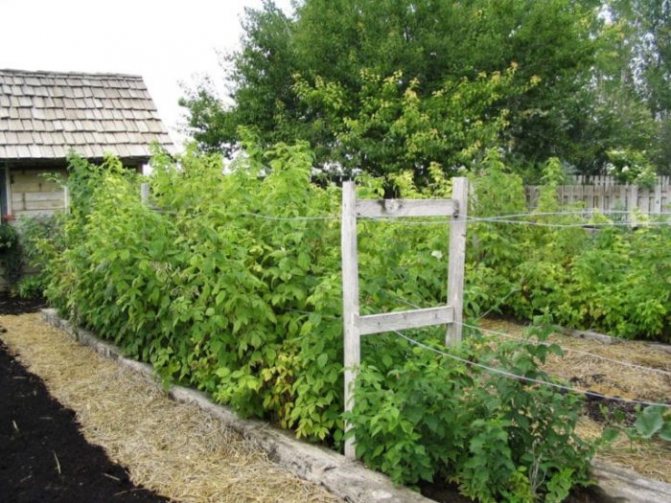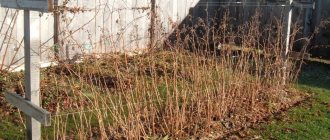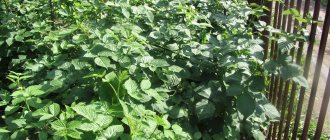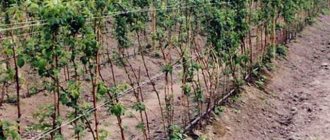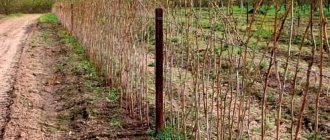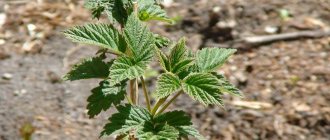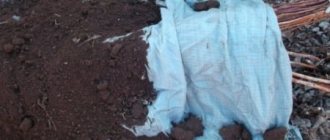The reasons for the growth of raspberries
When choosing a site, it is necessary to accurately identify where it is better to plant raspberries so that they do not interfere with the development of other plants. The reasons that can lead to the growth of the berry lie in the peculiarities of its root system. A large number of small root outgrowths are found in the upper soil layer. They have many active buds, which can sprout young shoots during the season: this contributes to the rapid growth of the bushes.
Also, the reason for the excessive growth of raspberries can be improper adherence to the rules for planting a plant in the ground.
Note! When planting, the seedling should deepen by at least 30 cm, otherwise there is a high risk of growth among adult shrubs.
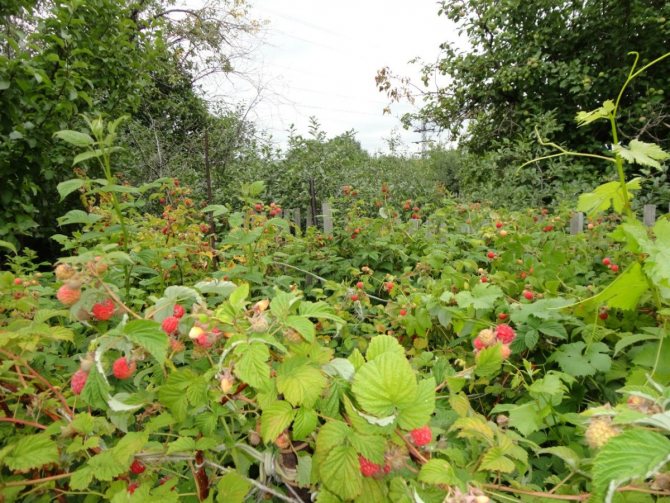
Overgrown raspberries are not pleasing to the eye
Do's and don'ts to plant next to raspberries
Among garden crops, there are other plants that will restrain the development of shoots. However, they will harm the shrub itself, oppressing it, slowing down the development and impairing the taste of the fruit. These include:
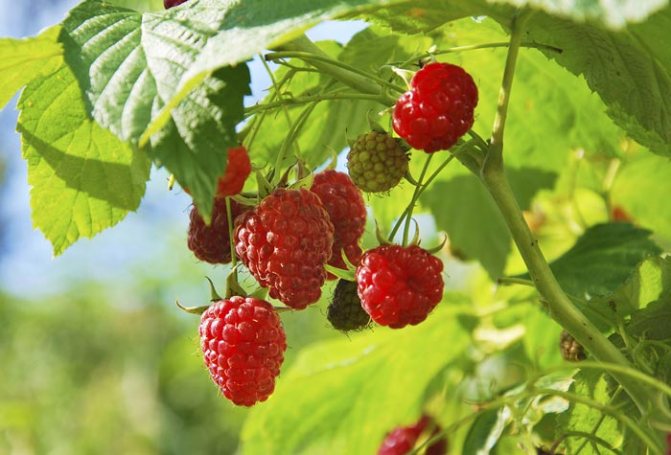

Some plants can contain the spread of raspberries
- grapes;
- cherry;
- flowers - hosta, nasturtium, marigolds, iris;
- sea buckthorn, jasmine.
The following plants are neutral to raspberries:
- apple, black currant, plum, black chokeberry, gooseberry;
- cabbage, pumpkin;
- mint, sage;
- flowers - lily, lilac, carnation, cosmos, calendula, rhododendron.
These cultures do not oppress raspberries, but they themselves calmly grow next to it.
The best neighbors of the bush will be:
- berries - barberry, red currant, strawberry;
- juniper and ferns;
- garden crops - cucumbers, tomatoes, potatoes, onions, peas, celery, carrots, dill, basil;
- flowers - roses, asters, peonies.
They will have a beneficial effect on the yield and taste of raspberries.
Many crops form a mutual defense against pests and diseases with raspberries. Spicy herbs attract insects to pollinate raspberries. To get the desired effect when working with a raspberry tree, you will probably need to apply several methods of stopping the growth at once.
Features of installing limiters when planting raspberries
Many gardeners are wondering how to plant raspberries so that they do not crawl around the site. To do this, it is necessary to use special restraints that reduce the growth activity of root shoots. They must be installed in the process of planting berries in open ground.
In order to place the restraints, you need to step back from the planting pit by 15 cm and dig a trench with a depth of at least 45 cm. A support is placed in it and covered with earth. The material used for the restraints can be anything, depending on the personal preference of the gardener. However, it must be remembered that it should not be harmful to other plants.
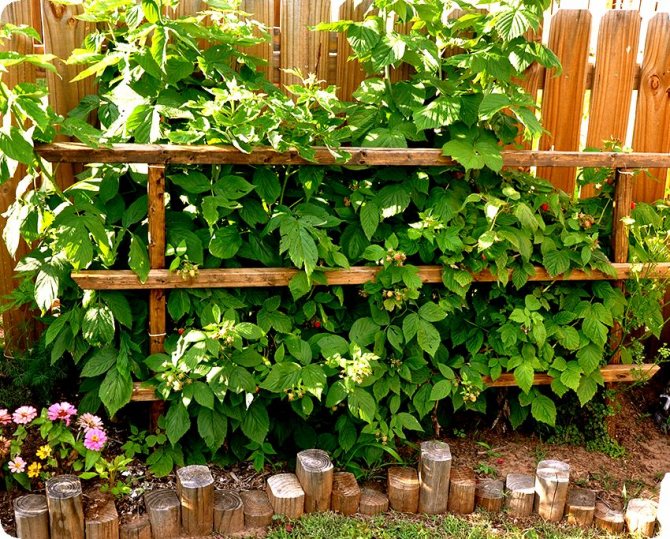

Limiters can be made from any material at hand
Note! During the growth period, the roots will not be able to pass the barrier and grow throughout the site. Thus, raspberries will not be able to interfere with the development of other crops.
Why is the raspberry growing
The root system of the shrub has incredible vitality, it can "capture" any free areas. Thin branches of the root penetrate into the smallest holes underground, grow and fill the entire space.The power of the system is so great that digging out a buried root takes a lot of effort.
However, such roots do not require restriction of growth, since they do not cause the active spread of the bush. The deep parts of the system are needed only for nutrition, the fight is against the root part of shallow depth.
Correct planting of raspberries, timing and maintenance tricks for a good harvest
Restriction methods
In order to know how to plant raspberries correctly so that they do not grow, you must first find out for yourself the advantages of its fencing:
- the process of caring for the plant is facilitated;
- with the help of limiters, you can give the raspberry to the desired shape;
- the plant is less susceptible to diseases;
- the raspberry does not thicken, which leads to the appearance of large berries.
The process of inhibition of root growth is a mandatory procedure at a summer cottage.
Barrier fence
The following materials can be used as fences:
- pieces of slate that are not damaged;
- metal sheets;
- old tires from car wheels;
- linoleum folded in several layers;
- plastic panels;
- dense multilayer polyethylene.
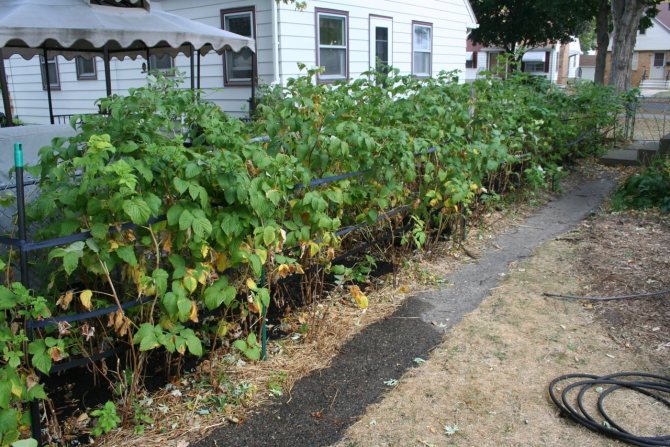

Raspberry barriers
This method of intervention blocks further root growth. At the same time, the plant is not exposed to the negative impact of other crops and does not reduce its yield.
Necessary measures
Raspberry mulching
So that the raspberry plant does not eventually turn into solid thickets of weeds, the gardener is forced to take a number of measures to prevent the rapid seizure of the territory:
- preventive action - fence around the perimeter pits (trenches) with barriers, preventing the roots from leaving their location; this will strengthen the main taproot and the raspberries will bear fruit better;
- the introduction of nitrogen fertilizing in the spring will redirect the forces of the bush to the growth of shoots, thereby slowing down the development of the roots;
- adopting the tricks of agricultural technology, you can use vegetable crops that inhibit the growth of raspberry rhizomes; therefore, it will be rational to plant beans and garlic on the beds on both sides of the raspberry tree.
Throughout the season, there is a struggle with offspring. Some of them are used as planting material, the rest is cut out without regret. Although experienced summer residents managed to use the berry-grower's ability to move to their advantage, rejuvenating the plantations in this way.
Pruning
In order to prevent thickening of the site, you should regularly trim excess shoots that are not involved in fruiting. As a rule, berries appear on second-year stems, of which there should be about 8-10 on the bush. After harvesting, in the fall, they are removed completely so that next year the dried (and already unusable) branches do not interfere with the development of replacement shoots.
Along with fruiting stems, several young shoots of the current year should develop on the bush, which will begin to yield in the next season. All the rest of the growth must be cut to the very root. This pruning is done throughout the summer.
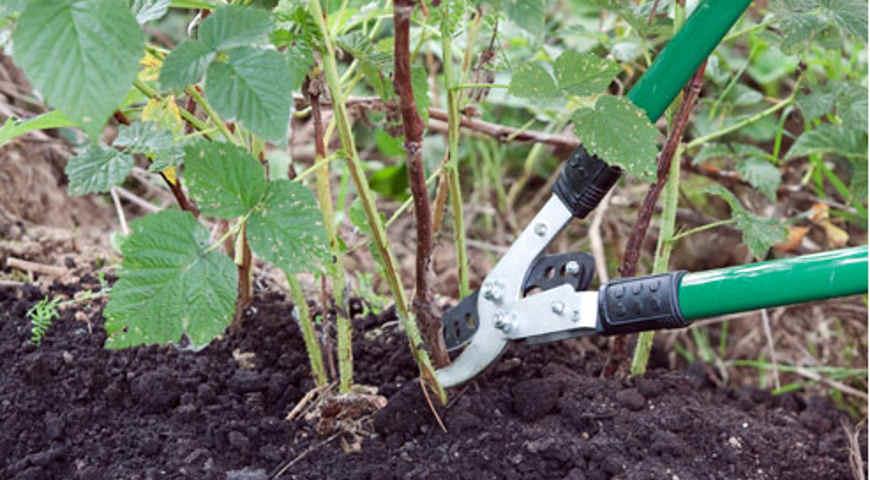

It needs to be cut to the very root
For a remontant variety, pruning is carried out in two ways. If the goal of the gardener is to get 2 crops per season, then in the fall two-year-old shoots are cut, and the young are only slightly shortened. To get one, but a large enough harvest of large berries, all shoots are cut off in November, leaving small stumps on the bush.
It is necessary to clean the berry not only near the bush, but also at a considerable distance from it. The shoots that have grown on lateral roots that have “run away” away from the mother liquor are removed. These shoots are not just cut off, but cut to the depth of the raspberry roots, not giving them the opportunity to root new bushes in an undesirable place.
Such work on the formation of a raspberry tree is effective only if there is no large thickening.
When the bush was not watched for some time, and it managed to grow significantly, the best way out in solving the problem is to uproot the berry, since ordinary pruning can provoke old bushes to form new shoots.
In this situation, it is worthwhile to tune in to the fact that it will take a couple of years to clear the neglected area so that the dacha looks like a picture. And only then at this place to plant a new berry or start a vegetable garden.
Barrier fence
Another way that you can take to prevent raspberries from growing over the site is to use fencing. This procedure is carried out even before planting seedlings.
Having decided on the planting scheme, they dig holes or a trench, taking into account the depth of the raspberry root system. As mentioned above, the main underground stem is located 15 cm from the surface of the earth. The lateral root can go deeper by another 10 centimeters. In total, the depth of the root system is 25 cm.
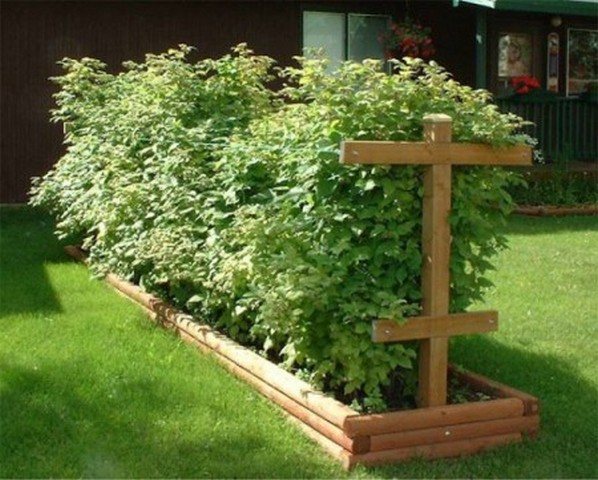

Barrier fence
Trenches (or holes) should be deepened by half a meter - for laying drainage and a layer of fertilizers. Now it's time to solve the problem of how to protect raspberries from overgrowth. A strong barrier will help limit the spread of rhizomes on the site. For this purpose, roofing material, sheets of metal, curb tape, slate, plastic are used. The width of the material should be 0.5-0.7 m.
When deciding how to properly enclose raspberries so that they do not grow, the walls of the recess are lined with barrier sheets so that there are no gaps. Consequently, the enclosing material must also be solid, without cracks and holes. It is desirable that the sheets rise slightly above the ground - it is more convenient to apply fertilizers and water the bushes under such bumpers.
An equipped barrier will prevent roots from growing outside the trench, so the bush will receive more nutrients.
Each radicular process receives a restriction in development and gives less growth, which is easier to deal with. The fence will also prevent the berry grower from climbing over the fence to the neighbor, saving you from unnecessary trouble.
Movement and rejuvenation
The slogan “Youth is on the move” is relevant not only for people. This is one of the ways you can ennoble raspberries using the culture's habit of "traveling".
The berry does not just grow on the site - it moves. If you do not clean the bush, then the spawned stems will gradually break off and begin to fall. But while they are on the plant, new shoots are looking for a place in the neighborhood. And so, season after season, the plantation is shifting.
In this case, the growth begins to grow chaotically in all directions. To prevent this from happening, the gardener adjusts the movement in the direction he needs. But under this technique, you will have to immediately allocate an extensive (as far as possible) area, enclosing it with a small fence or curb. This will make it possible to understand when to stop the movement.
Using this method of rejuvenation, you need to know how best to protect raspberries from unnecessary movement. The trench should be framed with sheets only on one side and at the ends, indicating in this way the path of movement to the raspberries. First, one row is formed, carrying out the necessary trimming. All extra stems from the bush and shoots within a radius of one and a half meters from it are completely cut off.
Those shoots that have gone further become material for the next row. When it is sufficiently formed, all the necessary pruning is practiced. And so gradually, row by row, the berry will move to the opposite edge of the site. Further inclinations will need to be stopped with a barrier (how to fence raspberries, described above).
Within a few years, the summer resident will have a whole plantation.And every raspberry bush will produce excellent harvests. But as soon as the last row, the most distant, begins to reproduce, it is recommended to destroy the first.
Such a creative technique is good in that there is no need to transplant bushes. The root system is not damaged either, which has a beneficial effect on the immunity of plants.
Another way to rejuvenate
Nursery rejuvenation using the method of moving is also used on the old berry. This frees from the complete removal of bushes that have reached 15 years of age. The weakest plants are selected and dug out without touching the neighboring ones.
These works are carried out either in early spring or in mid-September. To cut the roots, the shovel is buried on the entire bayonet at an angle, digging along the entire perimeter around the plant. The removal of the old bush must be done carefully so as not to damage the root suckers.
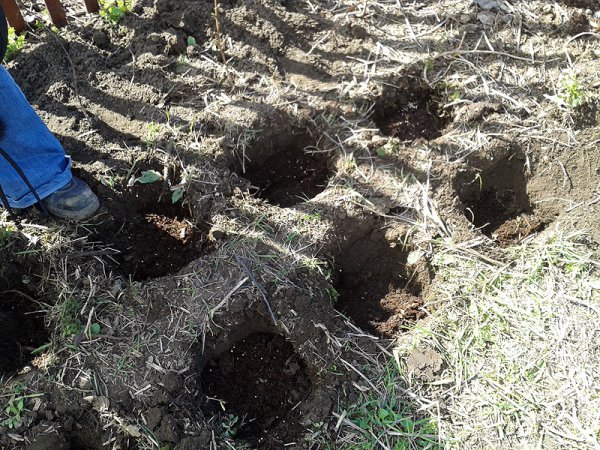

Digging up the weakest plants
The pits formed after the removal of the bush are covered with humus (compost) and watered abundantly. In the spring of next year, the whole berry is fertilized with a complex mineral water. The remaining offspring will give a bountiful harvest, and young shoots will appear on the branch of the roots, which will become the beginning of a new berry plant. In another year, full-fledged replacement shoots will grow here.
The old berry is thinned out every season at the same time, following the described algorithm. In 4 years, the raspberry plant will shift half a meter to the side. In order for such movement not to be chaotic, it must be directed, suppressing the development of the overgrowth on one side.
In a few years, the plantation will be completely rejuvenated, having moved to a new place, and will take on a beautiful view. At the same time, fruiting does not stop - the gardener will receive bountiful harvests every year.
The area freed from under the old raspberries can be temporarily filled with other garden crops or a vegetable garden can be set up. When the time comes to rejuvenate the migrated plantations, the plants can be wrapped in their old place, spending several years on the movement.
Raspberries grow more slowly on the site than blackberries, but without proper care they can turn a dacha into forest thickets in 3 years. To prevent this, you should take all measures that can stop the invasion of the berry, or take control of the movement, rejuvenating the raspberry plantation in this way.
How to uproot raspberries in the area
The complete physical elimination of the top and root of the plant is the main method for removing raspberries. It's hard to cope with the overgrowth without it. Grubbing up raspberries means digging up a site, which requires a handy shovel with a long blade and enough free time.
It is important to take into account the fact that you will have to dig up the soil at least 2-3 times, since in one approach it will not be possible to remove small roots. The technique can be used at any time of the year, with the exception of winter due to the inconvenience and hardness of the soil.
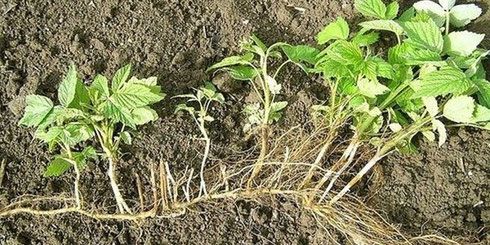

For efficiency, it is recommended to carry out the first uprooting in early spring after the snow has melted, when the ground has softened. Then, by the end of spring or summer months, the remaining roots will give superficial growth and the procedure will be repeated. In a year, you can get rid of raspberries on the site.
The uprooting process takes place according to the following scheme:
- the tops of the raspberries are cut off with a pruner or a hatchet at a height of 15-20 cm above the ground (for easy pulling out of the roots);
- a deep digging of the site is carried out with a shovel;
- underground parts are removed manually;
- the soil is crushed to remove roots.
If there is little time for removing raspberries, then another of the above methods is used. This is the use of chemical herbicides, covering the area or folk methods.
How to fence properly?
In order for the root system to form correctly, the bush must be fenced.For this, various methods are used.
Read also: Quick buns for tea in the oven recipe
Nitrogen fertilizing
Nitrogen fertilizing - urea, ammonium nitrate helps to resist the growth of raspberry rhizomes. Top dressing is carried out in early spring, when the buds awaken, and young shoots are actively developing. Gardeners, for example, use this recipe:
- superphosphate - 60 g;
- ammonium nitrate - 30 g;
- ash - 40 g;
- water - 10 liters.
The dry components are dissolved in water, the resulting mixture is poured under the root of the bushes.
How to protect?
One way to stop the migration of culture across the site is to establish a physical barrier. To do this, you can use improvised means, construction waste. The material must be firm enough, free from holes and not decompose in the soil.
How to prevent growth with cellophane?
For this way you need a thick plastic wrap... Materials for waterproofing or swimming pools (for example, butyl rubber foil, roofing felt) are also suitable.
The material is laid out along the edges of a trench or hole when planting a bush, the lower edges are sprinkled with earth. The depth should be at least 50 cm. The material is taken 15–20 cm wider. If it is not possible to cover the ground with one piece, the parts are glued together with tape.
Slate fencing
This method requires slate and grinder. A fence is made of asbestos-cement sheets for the entire row.
Construction consists of the following stages:
- Pegs are placed around the garden in those places where it is planned to equip the fence, and the thread is pulled.
- A trench 30 cm deep is dug under the established marks.
- Slate sheets are cut so that pieces of 60 cm high are obtained.
- The stretched thread is lowered flush with the ground.
- Slate sheets are installed in the trench so that 20 cm remains from the thread to the upper edge of the sheet.
- They cover the trench with earth.
How to make an iron barrier?
Iron is also a good raspberry fence. The construction algorithm is the same as when installing slate. But iron has a drawback: when immersed in the soil, moisture will act on it, as a result of which foci of corrosion are formed. Therefore, the material is first treated with water-repellent agents - for example, liquid bitumen.
Which plants prevent overgrowth?
On the site, you can equip and "hedge". Some plants will prevent raspberry overgrowth.
For example, in the aisles you can plant:
This method has a double benefit: you can save on materials and get a harvest of greens to the table.
Pruning a bush
Young shoots are destroyed at a very early stage of development, if there is no purpose to multiply raspberries. This will not only help keep the area clean, but will also give additional strength to the rest of the shoots.
Thinning of overgrown raspberries is carried out in several stages:
- In the spring, with the arrival of heat, they examine the bushes. Dry, broken, poorly developed shoots are removed, leaving only 10-15 trunks per running meter. The rest are shortened by 20-25 cm.
- In summer, after picking berries, prune two-year-old shoots to ground level. Weak young trunks up to 50 cm high, growing in groups, are regularly dug up. Only the strongest stems are left within a radius of no further than 30 cm.
- In autumn, 3 weeks before the onset of cold weather, cut out the fruiting, old, diseased and dried shoots. The shoots are dug out so that the distance between the bushes remains 60 cm or more.
Movement and rejuvenation
The shrub does not just grow, but moves. An alternative technique called "movement and rejuvenation" uses this cultural property that helps to keep the raspberry neat.
But this method has other advantages as well. It helps to maintain the integrity of the root and plant immunity, which has a positive effect on the quality of the crop. The culture is less likely to get sick, and the raspberry tree is constantly rejuvenating in a natural way without transplanting.
To grow raspberries using this technology, as much space as possible is allocated on the site.
Growing up consists of the following stages:
- Along the long side of the plot and from the ends, boundary shields are installed, as described above, under which a row of raspberries is planted.
- When young growth appears, everything that is closer than 1.5 m to the mother plant is destroyed.
- A new row is formed from young bushes located further than 1.5 m.
- Repeat until the area is completely filled with raspberries.
- Restriction sheets are buried on the opposite side.
- Old rows are gradually destroyed for 5-6 years.
How to protect an area from raspberries
If raspberries grow on the bordering area, but the neighbors do not plan to get rid of them, it is recommended to hold a special fence. For this purpose it is used:
- solid insulating material;
- cordon of some plant species.
Raspberry roots are able to break through fragile materials (roofing material, for example). For fencing the site, preference is given to slate sheets or rubber tires from a car.
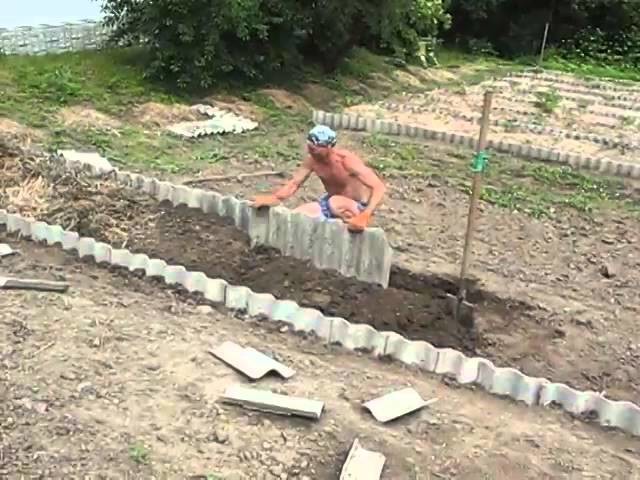

Restrictors are buried in the soil along the perimeter of the growth of berry plantations in order to protect other garden or horticultural crops from them. Another application is to protect your own area from the roots of neighboring raspberries.
The depth of the vertical placement of the layers of the insulator is 60-70 cm. Indicators up to 100 cm are allowed so that the raspberry roots do not pass under the border.
Another popular option is to plant sorrel, corn, parsley or garlic bushes along the cordon. Raspberries do not like such a neighborhood and will not cross the plants. Green fertilizers effectively muffle the growth of young raspberry shoots.
Video
Many gardeners grow raspberries. Already in the first year, they are faced with the fact that the plant sprouts in neighboring beds. Answering the question of how to prevent the growth of raspberries, experts recommend paying attention to several important factors at once during planting and subsequent care.
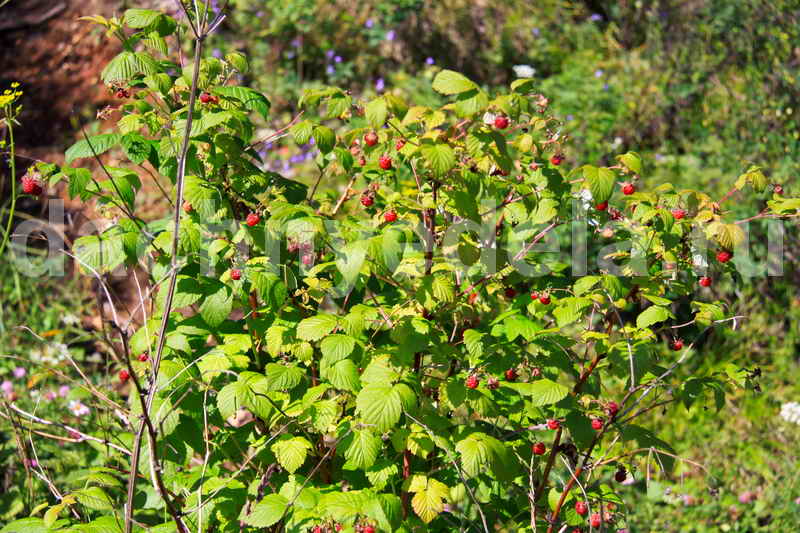

Growing raspberries
How to get rid of young growth
For many gardeners and summer residents, the raspberry tree turns into a real problem that takes a lot of time and effort. Every autumn they cut down unnecessary shoots, and every spring the young growth appears more than before. This situation often occurs after the raspberry tree has been moved to another place. It is known that raspberries need to be replanted every 5-6 years, otherwise they degenerate, the berries become small, and the yield decreases. Unfortunately, getting rid of raspberries is much more difficult than starting them.
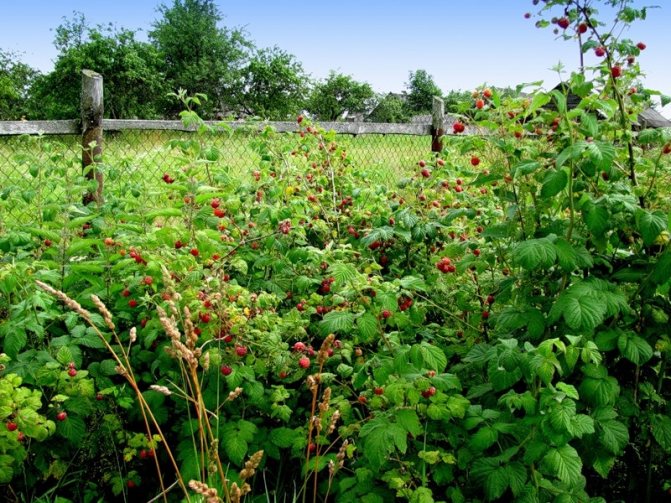

Often, raspberries are transferred from neighbors. If they have a raspberry tree located near a fence next to you, then the probability of a growth on your site is almost 100%. What to do with young growth and how to get rid of it? Each gardener has his own proven method for this case. However, you need to understand that this process will most likely take you more than one year, so you should not hope for a quick result.
If young growth has appeared recently, then it is much easier to deal with it. The first thing to do is to dig up the area in early spring, while the shoots are not yet branches, and at the same time remove all roots and shoots from the soil.
Over time, when the grass begins to grow, the raspberries will also sprout, so the digging is carried out again. It makes no sense to simply cut or mow young shoots, since a remote bush will still give growth from the remaining root, and in larger quantities.
However, you can find many reviews that it was through regular mowing that it was possible to defeat unwanted growth. If you decide to resort to this method, then be prepared that you will need to mow the shoots very often, and cut the shoots at the very base of the shoot, below the growth bud.
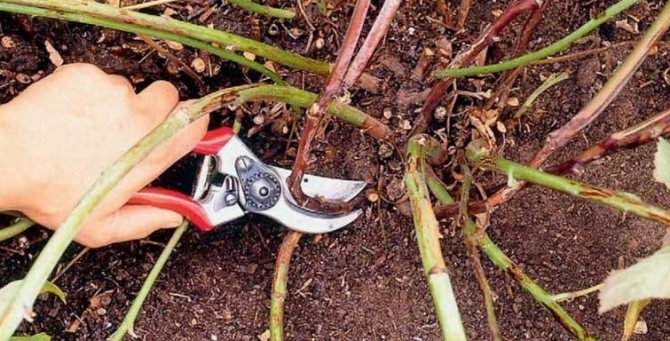

Some gardeners prefer to plant such plots with vegetables: carrots, potatoes, tomatoes.Of course, in this case, the growth of raspberries will not be so intense, but the shoots will still appear, and thereby interfere with the growth of vegetables. If you really decide to plant something on this site, then give preference to siderates. They grow very quickly and can drown out raspberries.
If you don't have enough patience to fight mechanically, then you can try more serious means - herbicides. The drug Roundup has proven itself well in the destruction of raspberries. It is a continuous herbicide most commonly used in agriculture for weed control. However, it is possible to destroy raspberries with this tool only after repeated processing, and it is necessary to process not only each raspberry bush, but also the soil. In addition to Roundup, you can use other drugs with a similar effect: Hurricane, Tornado, Glyfovit, Alaz.
How to etch raspberries
The use of chemicals is justified in the case of allotting a site for further development or other household needs. You will have to etch raspberries 2-3 times. After such procedures, the soil becomes unsuitable for growing other crops.
The bush and soil are treated with herbicides, but it is more effective to pre-cut the tops at ground level.
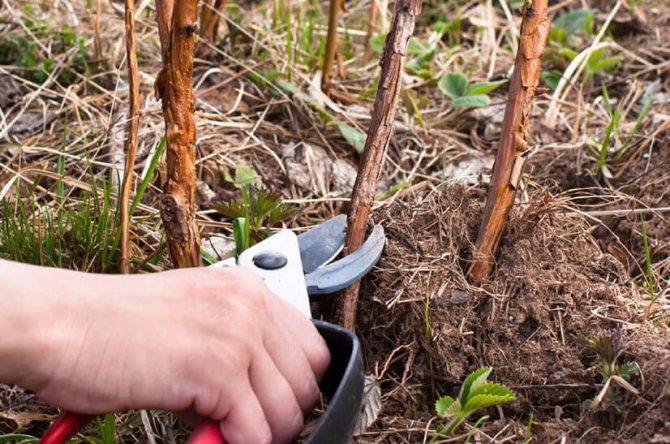

After that, it is recommended to coat the bushes with undiluted means and spray the soil around the territory.
The fact is taken into account that you cannot do without digging up the soil. The herbicide destroys the central rhizome, but small shoots will remain and will soon make their way out. Another way is to combine the uprooting and subsequent application of chemicals to the dug soil.
To poison raspberries, they use a weed and overgrowth remedy called Roundup. The drug is considered strong and effective, but 2-3 repeated treatments of the site will have to be done. Analogs such as Alaz, Tornado, Hurricane, Glyfovit are considered alternative options.
What to do to limit the growth of the bush?
Prevention is the main way to limit the growth of the bush. It is also helpful to learn other gardeners' know-how. Many of them can be even more effective than the ones listed above.
Preventive measures
To keep raspberries from growing too much, they need constant care. Prevention of blockage of the site by young shoots will be:
- regular pruning of young, but weak seedlings;
- landing in "smart beds", when the trench is upholstered with boards around the edges;
- laying paths along the raspberry tree - the roots will not penetrate through the rammed earth;
- choice for planting remontant varieties that give less root shoots.
Site selection and tire preparation
It is advisable for improvised flower beds to choose areas on which greens, onions or legumes were grown last year. The places where nightshades were planted are not suitable - the risk of diseases of fungal etiology increases. It is better to place raspberries against walls, solid fences, next to trees - a single bush must be protected from the wind. Care should be taken about the permissible humidity - if the groundwater is high, you should choose a different part of the garden.
The tires are installed at a distance of 1.5 m, not closer. You can dig them in next to them, or place them on sunny free places of the site. In each tire, a sidewall is removed, which is planned to be placed on top - in order to increase the internal space. It is advisable to wash the rubber with a detergent with a degreasing effect, and then rinse with clean water.
Plant raspberries in a bucket
If you have a small raspberry tree and you want to beautifully equip the site, use additional decor. Use a personal fence for each raspberry bush. You can make it from an ordinary bucket: cut off the bottom of the bucket and dig it into the ground, with the wide part down.Place a shrub in such a blank: the plant will look unusual, while the growth of new shoots will stop. By the same principle, you can use old flower pots with a large volume or barrels that will not be needed on the farm.
How to remove raspberries: ways
The need to get rid of raspberry bushes arises for various reasons. The main ones are:
- old shrubs or shrubs affected by fungal disease with low yield readings;
- the desire to move the raspberry to a new place;
- muffling of growth and fruiting of other crops by raspberries;
- cleaning of the site for construction and others.
It happens that raspberries move from neighboring plots and interfere with the normal cultivation of garden or garden plants. The roots of a culture grow quickly, are distinguished by their vitality and unpretentiousness, if not dealt with, they can destroy the rest of the vegetation.
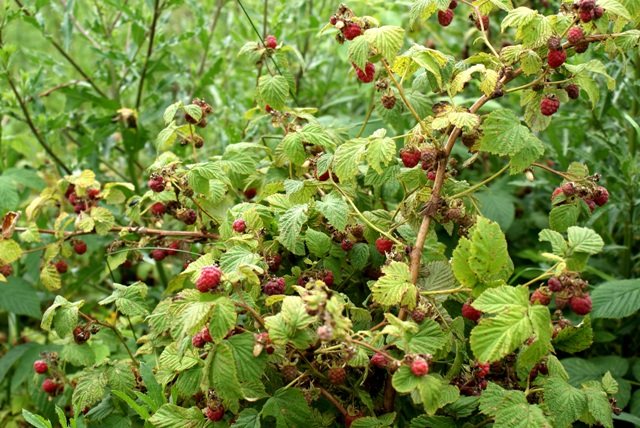

Raspberry breeders know that for a normal berry harvest, it is advisable to change the planting site every 5-7 years. So that the previous site after the transfer of the plant is not empty, it is planted with another crop. But since even a small root in the ground quickly gives rise to new growth, it is imperative to get rid of the raspberry residues.
Eliminate raspberries by one or a combination of techniques:
- digging the site and uprooting the roots;
- the use of chemical herbicides;
- covering the site with insulation;
- fencing of the territory;
- folk remedies.
The choice of method depends on the subsequent use of the treated area.

